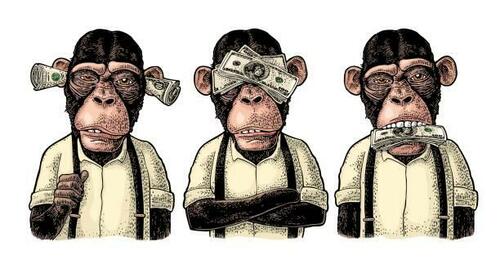
Authored by Conor MacNeil via 'Investment Talk' Substack,
Seth Klarman outlines the lessons that investors were quick to forget only two years following one of the greatest financial meltdowns in modern history...
Two years after the great financial crisis of 2008, Seth Klarman shared a memo explaining how he felt that investors were quick to forget the lessons learned from one of the greatest financial meltdowns in modern history. He would remark that these lessons “were either never learned or else were immediately forgotten by most market participants”. Not quite a like-for-like comparison, but today we are ~2 years post one of the strangest exogenous shocks to ever hit the market. In this short time, we witnessed excess, despair, and everything in between. Some are now calling for a recession and a prolonged bear market while others suggest we are on the precipice of a young bull market.
I have no idea myself, but I noticed that following one strong month (January) of 2023; the behaviours amongst retail investors that faded during 2021/22 (posting returns, portfolio breakdowns et al) have made a return. I don’t think there is anything inherently wrong with that; transparency is useful as far as contextualising people’s opinions is concerned. But it appears that some individuals are quick to forget the lessons of 2020 through 2022; deploying the same strategies that landed them in hot water previously.
Each new generation of investors suffers from involuntary amnesia; not being blessed with the scars from volatile periods in the market like their more tenured peers. I was not an investor during the GFC. Despite reading about it at length, I will never have the “benefit” of knowing what that felt like. These moments, while at times costly (both to your asset values and pride) are supposed to shape you; to make you a better investor for the decades to come. If you are fortunate enough to be young, then the lessons won’t appear so expensive further down the line. But the worst outcome is the investor who does experience something and learns nothing from it; voluntary amnesia.
As such, I thought this excerpt from Klarman’s 2010 shareholder letter would be an appropriate read. The individual who makes mistakes is not a fool. Rather, it is the person who makes the same mistakes, time and time again.
The Forgotten Lessons of 2008
Seth Klarman
One might have expected that the near-death experience of most investors in 2008 would generate valuable lessons for the future. We all know about the “depression mentality” of our parents and grandparents who lived through the Great Depression. Memories of tough times colored their behavior for more than a generation, leading to limited risk taking and a sustainable base for healthy growth. Yet one year after the 2008 collapse, investors have returned to shockingly speculative behavior. One state investment board recently adopted a plan to leverage its portfolio – specifically its government and high-grade bond holdings – in an amount that could grow to 20% of its assets over the next three years. No one who was paying attention in 2008 would possibly think this is a good idea.
Below, we highlight the lessons that we believe could and should have been learned from the turmoil of 2008. Some of them are unique to the 2008 melt- down; others, which could have been drawn from general market observation over the past several decades, were certainly reinforced last year. Shockingly, virtually all of these lessons were either never learned or else were immediately forgotten by most market participants.
Twenty Investment Lessons of 2008
-
Things that have never happened before are bound to occur with some regularity. You must always be prepared for the unexpected, including sudden, sharp downward swings in markets and the economy. Whatever adverse scenario you can contemplate, reality can be far worse.
-
When excesses such as lax lending standards become widespread and persist for some time, people are lulled into a false sense of security, creating an even more dangerous situation. In some cases, excesses migrate beyond regional or national borders, raising the ante for investors and governments. These excesses will eventually end, triggering a crisis at least in proportion to the degree of the excesses. Correlations between asset classes may be surprisingly high when leverage rapidly unwinds.
-
Nowhere does it say that investors should strive to make every last dollar of potential profit; consideration of risk must never take a backseat to return. Conservative positioning entering a crisis is crucial: it enables one to maintain long-term oriented, clear thinking, and to focus on new opportunities while others are distracted or even forced to sell. Portfolio hedges must be in place before a crisis hits. One cannot reliably or affordably increase or replace hedges that are rolling off during a financial crisis.
-
Risk is not inherent in an investment; it is always relative to the price paid. Uncertainty is not the same as risk. Indeed, when great uncertainty – such as in the fall of 2008 – drives securities prices to especially low levels, they often become less risky investments.
-
Do not trust financial market risk models. Reality is always too complex to be accurately modeled. Attention to risk must be a 24/7/365 obsession, with people – not computers – assessing and reassessing the risk environment in real time. Despite the predilection of some analysts to model the financial markets using sophisticated mathematics, the markets are governed by behavioral science, not physical science.
-
Do not accept principal risk while investing short-term cash: the greedy effort to earn a few extra basis points of yield inevitably leads to the incurrence of greater risk, which increases the likelihood of losses and severe illiquidity at precisely the moment when cash is needed to cover expenses, to meet commitments, or to make compelling long-term investments.
-
The latest trade of a security creates a dangerous illusion that its market price approximates its true value. This mirage is especially dangerous during periods of market exuberance. The concept of “private market value” as an anchor to the proper valuation of a business can also be greatly skewed during ebullient times and should always be considered with a healthy degree of scepticism.
-
A broad and flexible investment approach is essential during a crisis. Opportunities can be vast, ephemeral, and dispersed through various sectors and markets. Rigid silos can be an enormous disadvantage at such times.
-
You must buy on the way down. There is far more volume on the way down than on the way back up, and far less competition among buyers. It is almost always better to be too early than too late, but you must be prepared for price markdowns on what you buy.
-
Financial innovation can be highly dangerous, though almost no one will tell you this. New financial products are typically created for sunny days and are almost never stress-tested for stormy weather. Securitization is an area that almost perfectly fits this description; markets for securitized assets such as subprime mortgages completely collapsed in 2008 and have not fully recovered. Ironically, the government is eager to restore the securitization markets back to their pre-collapse stature.
-
Ratings agencies are highly conflicted, unimaginative dupes. They are blissfully unaware of adverse selection and moral hazard. Investors should never trust them.
-
Be sure that you are well compensated for illiquidity – especially illiquidity without control – because it can create particularly high opportunity costs.
-
At equal returns, public investments are generally superior to private investments not only because they are more liquid but also because amidst distress, public markets are more likely than private ones to offer attractive opportunities to average down.
-
Beware leverage in all its forms. Borrowers – individual, corporate, or government – should always match fund their liabilities against the duration of their assets. Borrowers must always remember that capital markets can be extremely fickle, and that it is never safe to assume a maturing loan can be rolled over. Even if you are unleveraged, the leverage employed by others can drive dramatic price and valuation swings; sudden unavailability of leverage in the economy may trigger an economic downturn.
-
Many LBOs are man-made disasters. When the price paid is excessive, the equity portion of an LBO is really an out-of-the-money call option. Many fiduciaries placed large amounts of the capital under their stewardship into such options in 2006 and 2007.
-
Financial stocks are particularly risky. Banking, in particular, is a highly lever- aged, extremely competitive, and challenging business. A major European bank recently announced the goal of achieving a 20% return on equity (ROE) within several years. Unfortunately, ROE is highly dependent on absolute yields, yield spreads, maintaining adequate loan loss reserves, and the amount of leverage used. What is the bank’s management to do if it cannot readily get to 20%? Leverage up? Hold riskier assets? Ignore the risk of loss? In some ways, for a major financial institution even to have a ROE goal is to court disaster.
-
Having clients with a long-term orientation is crucial. Nothing else is as important to the success of an investment firm.
-
When a government official says a problem has been “contained,” pay no attention.
-
The government – the ultimate short- term-oriented player – cannot with- stand much pain in the economy or the financial markets. Bailouts and rescues are likely to occur, though not with sufficient predictability for investors to comfortably take advantage. The government will take enormous risks in such interventions, especially if the expenses can be conveniently deferred to the future. Some of the price-tag is in the form of back- stops and guarantees, whose cost is almost impossible to determine.
-
Almost no one will accept responsibility for his or her role in precipitating a crisis: not leveraged speculators, not willfully blind leaders of financial institutions, and certainly not regulators, government officials, ratings agencies or politicians.
Below, we itemize some of the quite different lessons investors seem to have learned as of late 2009 – false lessons, we believe. To not only learn but also effectively implement investment lessons requires a disciplined, often contrary, and long-term-oriented investment approach. It requires a resolute focus on risk aversion rather than maximizing immediate returns, as well as an understanding of history, a sense of financial market cycles, and, at times, extraordinary patience.
False Lessons
-
There are no long-term lessons – ever.
-
Bad things happen, but really bad things do not. Do buy the dips, especially the lowest quality securities when they come under pressure, because declines will quickly be reversed.
-
There is no amount of bad news that the markets cannot see past.
-
If you’ve just stared into the abyss, quickly forget it: the lessons of history can only hold you back.
-
Excess capacity in people, machines, or property will be quickly absorbed.
-
Markets need not be in sync with one another. Simultaneously, the bond market can be priced for sustained tough times, the equity market for a strong recovery, and gold for high inflation. Such an apparent disconnect is indefinitely sustainable.
-
In a crisis, stocks of financial companies are great investments, because the tide is bound to turn. Massive losses on bad loans and soured investments are irrelevant to value; improving trends and future prospects are what matter, regardless of whether profits will have to be used to cover loan losses and equity shortfalls for years to come.
-
The government can reasonably rely on debt ratings when it forms programs to lend money to buyers of otherwise unattractive debt instruments.
-
The government can indefinitely control both short-term and long-term interest rates.
-
The government can always rescue the markets or interfere with contract law whenever it deems convenient with little or no apparent cost. (Investors believe this now and, worse still, the government believes it as well. We are probably doomed to a lasting legacy of government tampering with financial markets and the economy, which is likely to create the mother of all moral hazards. The government is blissfully unaware of the wisdom of Friedrich Hayek: “The curious task of economics is to demonstrate to men how little they really know about what they imagine they can design.”)
* * *
Authored by Conor MacNeil via ‘Investment Talk’ Substack,
Seth Klarman outlines the lessons that investors were quick to forget only two years following one of the greatest financial meltdowns in modern history…
Two years after the great financial crisis of 2008, Seth Klarman shared a memo explaining how he felt that investors were quick to forget the lessons learned from one of the greatest financial meltdowns in modern history. He would remark that these lessons “were either never learned or else were immediately forgotten by most market participants”. Not quite a like-for-like comparison, but today we are ~2 years post one of the strangest exogenous shocks to ever hit the market. In this short time, we witnessed excess, despair, and everything in between. Some are now calling for a recession and a prolonged bear market while others suggest we are on the precipice of a young bull market.
I have no idea myself, but I noticed that following one strong month (January) of 2023; the behaviours amongst retail investors that faded during 2021/22 (posting returns, portfolio breakdowns et al) have made a return. I don’t think there is anything inherently wrong with that; transparency is useful as far as contextualising people’s opinions is concerned. But it appears that some individuals are quick to forget the lessons of 2020 through 2022; deploying the same strategies that landed them in hot water previously.
Each new generation of investors suffers from involuntary amnesia; not being blessed with the scars from volatile periods in the market like their more tenured peers. I was not an investor during the GFC. Despite reading about it at length, I will never have the “benefit” of knowing what that felt like. These moments, while at times costly (both to your asset values and pride) are supposed to shape you; to make you a better investor for the decades to come. If you are fortunate enough to be young, then the lessons won’t appear so expensive further down the line. But the worst outcome is the investor who does experience something and learns nothing from it; voluntary amnesia.
As such, I thought this excerpt from Klarman’s 2010 shareholder letter would be an appropriate read. The individual who makes mistakes is not a fool. Rather, it is the person who makes the same mistakes, time and time again.
The Forgotten Lessons of 2008
Seth Klarman
One might have expected that the near-death experience of most investors in 2008 would generate valuable lessons for the future. We all know about the “depression mentality” of our parents and grandparents who lived through the Great Depression. Memories of tough times colored their behavior for more than a generation, leading to limited risk taking and a sustainable base for healthy growth. Yet one year after the 2008 collapse, investors have returned to shockingly speculative behavior. One state investment board recently adopted a plan to leverage its portfolio – specifically its government and high-grade bond holdings – in an amount that could grow to 20% of its assets over the next three years. No one who was paying attention in 2008 would possibly think this is a good idea.
Below, we highlight the lessons that we believe could and should have been learned from the turmoil of 2008. Some of them are unique to the 2008 melt- down; others, which could have been drawn from general market observation over the past several decades, were certainly reinforced last year. Shockingly, virtually all of these lessons were either never learned or else were immediately forgotten by most market participants.
Twenty Investment Lessons of 2008
-
Things that have never happened before are bound to occur with some regularity. You must always be prepared for the unexpected, including sudden, sharp downward swings in markets and the economy. Whatever adverse scenario you can contemplate, reality can be far worse.
-
When excesses such as lax lending standards become widespread and persist for some time, people are lulled into a false sense of security, creating an even more dangerous situation. In some cases, excesses migrate beyond regional or national borders, raising the ante for investors and governments. These excesses will eventually end, triggering a crisis at least in proportion to the degree of the excesses. Correlations between asset classes may be surprisingly high when leverage rapidly unwinds.
-
Nowhere does it say that investors should strive to make every last dollar of potential profit; consideration of risk must never take a backseat to return. Conservative positioning entering a crisis is crucial: it enables one to maintain long-term oriented, clear thinking, and to focus on new opportunities while others are distracted or even forced to sell. Portfolio hedges must be in place before a crisis hits. One cannot reliably or affordably increase or replace hedges that are rolling off during a financial crisis.
-
Risk is not inherent in an investment; it is always relative to the price paid. Uncertainty is not the same as risk. Indeed, when great uncertainty – such as in the fall of 2008 – drives securities prices to especially low levels, they often become less risky investments.
-
Do not trust financial market risk models. Reality is always too complex to be accurately modeled. Attention to risk must be a 24/7/365 obsession, with people – not computers – assessing and reassessing the risk environment in real time. Despite the predilection of some analysts to model the financial markets using sophisticated mathematics, the markets are governed by behavioral science, not physical science.
-
Do not accept principal risk while investing short-term cash: the greedy effort to earn a few extra basis points of yield inevitably leads to the incurrence of greater risk, which increases the likelihood of losses and severe illiquidity at precisely the moment when cash is needed to cover expenses, to meet commitments, or to make compelling long-term investments.
-
The latest trade of a security creates a dangerous illusion that its market price approximates its true value. This mirage is especially dangerous during periods of market exuberance. The concept of “private market value” as an anchor to the proper valuation of a business can also be greatly skewed during ebullient times and should always be considered with a healthy degree of scepticism.
-
A broad and flexible investment approach is essential during a crisis. Opportunities can be vast, ephemeral, and dispersed through various sectors and markets. Rigid silos can be an enormous disadvantage at such times.
-
You must buy on the way down. There is far more volume on the way down than on the way back up, and far less competition among buyers. It is almost always better to be too early than too late, but you must be prepared for price markdowns on what you buy.
-
Financial innovation can be highly dangerous, though almost no one will tell you this. New financial products are typically created for sunny days and are almost never stress-tested for stormy weather. Securitization is an area that almost perfectly fits this description; markets for securitized assets such as subprime mortgages completely collapsed in 2008 and have not fully recovered. Ironically, the government is eager to restore the securitization markets back to their pre-collapse stature.
-
Ratings agencies are highly conflicted, unimaginative dupes. They are blissfully unaware of adverse selection and moral hazard. Investors should never trust them.
-
Be sure that you are well compensated for illiquidity – especially illiquidity without control – because it can create particularly high opportunity costs.
-
At equal returns, public investments are generally superior to private investments not only because they are more liquid but also because amidst distress, public markets are more likely than private ones to offer attractive opportunities to average down.
-
Beware leverage in all its forms. Borrowers – individual, corporate, or government – should always match fund their liabilities against the duration of their assets. Borrowers must always remember that capital markets can be extremely fickle, and that it is never safe to assume a maturing loan can be rolled over. Even if you are unleveraged, the leverage employed by others can drive dramatic price and valuation swings; sudden unavailability of leverage in the economy may trigger an economic downturn.
-
Many LBOs are man-made disasters. When the price paid is excessive, the equity portion of an LBO is really an out-of-the-money call option. Many fiduciaries placed large amounts of the capital under their stewardship into such options in 2006 and 2007.
-
Financial stocks are particularly risky. Banking, in particular, is a highly lever- aged, extremely competitive, and challenging business. A major European bank recently announced the goal of achieving a 20% return on equity (ROE) within several years. Unfortunately, ROE is highly dependent on absolute yields, yield spreads, maintaining adequate loan loss reserves, and the amount of leverage used. What is the bank’s management to do if it cannot readily get to 20%? Leverage up? Hold riskier assets? Ignore the risk of loss? In some ways, for a major financial institution even to have a ROE goal is to court disaster.
-
Having clients with a long-term orientation is crucial. Nothing else is as important to the success of an investment firm.
-
When a government official says a problem has been “contained,” pay no attention.
-
The government – the ultimate short- term-oriented player – cannot with- stand much pain in the economy or the financial markets. Bailouts and rescues are likely to occur, though not with sufficient predictability for investors to comfortably take advantage. The government will take enormous risks in such interventions, especially if the expenses can be conveniently deferred to the future. Some of the price-tag is in the form of back- stops and guarantees, whose cost is almost impossible to determine.
-
Almost no one will accept responsibility for his or her role in precipitating a crisis: not leveraged speculators, not willfully blind leaders of financial institutions, and certainly not regulators, government officials, ratings agencies or politicians.
Below, we itemize some of the quite different lessons investors seem to have learned as of late 2009 – false lessons, we believe. To not only learn but also effectively implement investment lessons requires a disciplined, often contrary, and long-term-oriented investment approach. It requires a resolute focus on risk aversion rather than maximizing immediate returns, as well as an understanding of history, a sense of financial market cycles, and, at times, extraordinary patience.
False Lessons
-
There are no long-term lessons – ever.
-
Bad things happen, but really bad things do not. Do buy the dips, especially the lowest quality securities when they come under pressure, because declines will quickly be reversed.
-
There is no amount of bad news that the markets cannot see past.
-
If you’ve just stared into the abyss, quickly forget it: the lessons of history can only hold you back.
-
Excess capacity in people, machines, or property will be quickly absorbed.
-
Markets need not be in sync with one another. Simultaneously, the bond market can be priced for sustained tough times, the equity market for a strong recovery, and gold for high inflation. Such an apparent disconnect is indefinitely sustainable.
-
In a crisis, stocks of financial companies are great investments, because the tide is bound to turn. Massive losses on bad loans and soured investments are irrelevant to value; improving trends and future prospects are what matter, regardless of whether profits will have to be used to cover loan losses and equity shortfalls for years to come.
-
The government can reasonably rely on debt ratings when it forms programs to lend money to buyers of otherwise unattractive debt instruments.
-
The government can indefinitely control both short-term and long-term interest rates.
-
The government can always rescue the markets or interfere with contract law whenever it deems convenient with little or no apparent cost. (Investors believe this now and, worse still, the government believes it as well. We are probably doomed to a lasting legacy of government tampering with financial markets and the economy, which is likely to create the mother of all moral hazards. The government is blissfully unaware of the wisdom of Friedrich Hayek: “The curious task of economics is to demonstrate to men how little they really know about what they imagine they can design.”)
* * *
Loading…





